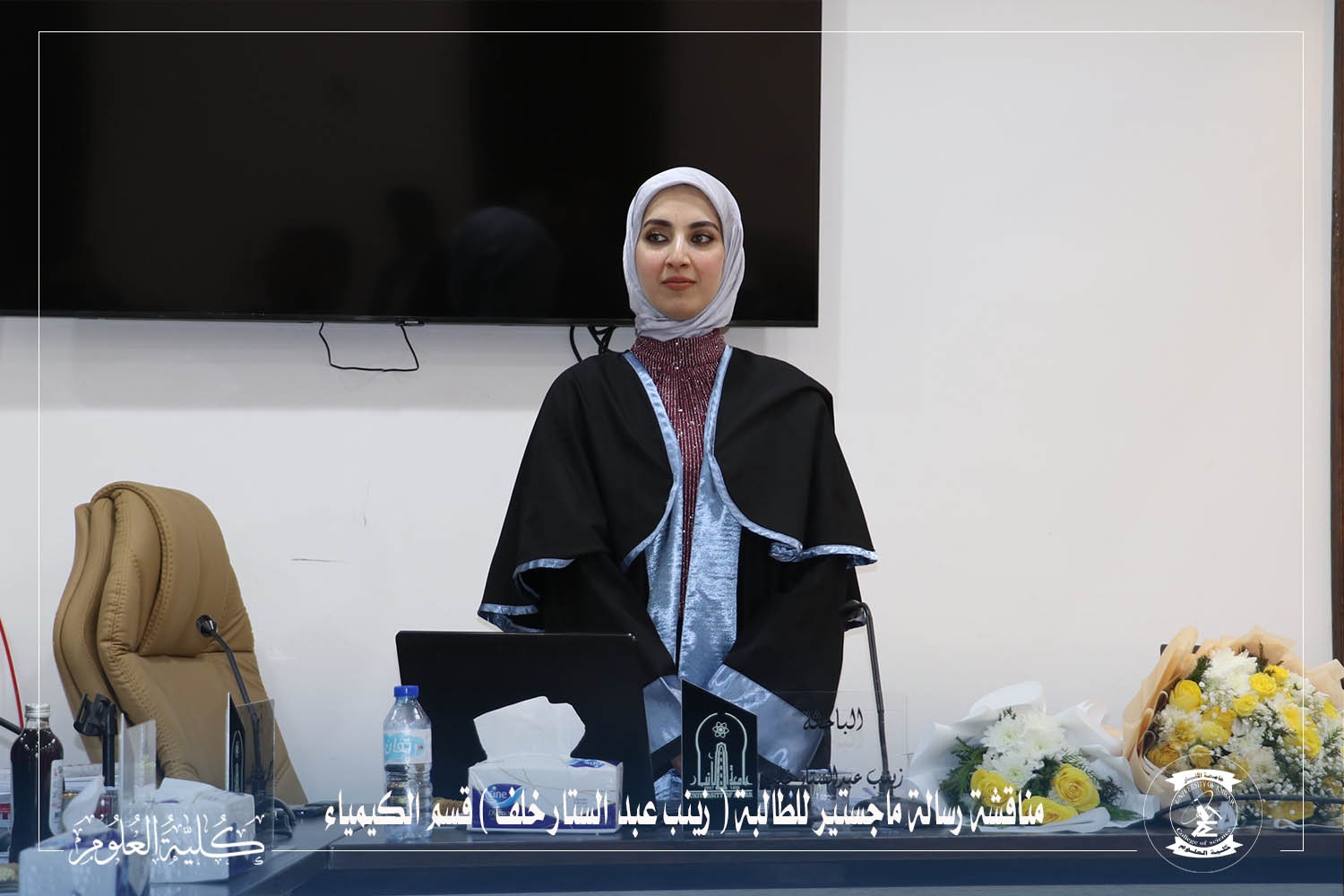
Discussion of the master’s thesis by the student (Zainab Abdul Sattar Khalaf)
The public discussion took place for the master’s student (Zainab Abdul Sattar Khalaf) Department of Chemistry - University of Anbar on Sunday 1/9/2024 in Ibn Sina Hall. for his tagged thesis
" Biosynthesis of Selenium and palladium nanoparticles as antioxidant, antifungal, and anticancer agents "
The discussion committee consisted of:
|
University of Anbar - College of Science - President |
Prof. Dr. Hamid Hussein Ali |
|
University of Anbar - College of Science -Member |
Assist. Prof. Dr. Yusra Mahmoud Hammadi |
|
University of Baghdad - College of Agricultural Engineering Sciences - Member |
Assist. Prof. Dr. Mohammed Fayyad Nayef |
|
University of Anbar - College of Science - member and supervisor |
Prof. Dr. Ahmed Mishaal Mohammed |
|
University of Anbar - College of Pharmacy - Member and Supervisor |
Prof. Dr. Youssef Hindi Khalaf |
This study aimed to Nanotechnology has the potential to completely transform the medical field, From tailored therapeutics to diagnostic. Nanomaterials show effective antioxidant, antifungal and anticancer properties, making them promising biomedical agents. With a variety of therapeutic uses, turmeric extract is a promising natural resource. It has a range of phytochemicals, including polyphenols and curcuminoids, which function as ions' stabilizers and reducers to produce nanoparticles. In this study, through the use of an environmentally friendly technique, the multifunctional biogenic Selenium (Se) nanospheres Palladium (Pd) nanoparticles were prepared from aqueous turmeric extract (Curcuma longa) for the assessment of thier antifungal, antioxidant, and anticancer properties. The biogenic Se-nanospheres and Pd-NPs were characterized using UV-visible spectroscopy, Fourier transform infrared spectroscopy (FT IR), X-ray diffraction Pattern (XRD), Field Emission Scanning Electron Microscope (FE-SEM), and transmission electron microscope (TEM) which proved that these nanoparticles have distinctive chemical and physical characteristics. The UV-visible spectrum exhibited observed peak at 260nm for Se-nanospheres, while for Pd-NPs it was observed at 419nm. And FT-IR spectrum showed various peaks for the prepared nanoparticles. The surface morphology (FE-SEM,TEM) showed spherical shapes for Se-nanospheres and nanoparticles for Palladium, with diameters ranging (25nm-45nm) and (50nm-150nm) respectively. The antioxidant properties of Se-nanospheres and Pd-NPs were determined against DPPH (2,2-diphenyl-1-picrylhydrazyl) radicals using DPPH assay. Also, the antifungal properties were determined against Candida species using an agar well diffusion assay. Additionally, The cytotoxic MTT assay was utilized to ascertain the anti-cancer capabilities of these nanoparticles against the human MCF7 cell line. In a dose-dependent manner, biosynthesized nanoparticles (Se nanospheres and Pd-NPs) have demonstrated high efficiency as antioxidant, antifungal, and anti-cancer medicines., and Se-nanospheres have shown higher efficiency compared to Pd-NPs. The scavenging rate of radicals at higher concentrations, for Se-nanospheres (115µg/mL) was 76%, while it was 33% for Pd-NPs (130µg/mL). In addition, growth inhibition of candida species by Se-nanospheres (115 µg/mL) and Pd-NPs (130 µg/mL) was 24± 0.25 and 17± 0.14 respectively. The rate of residual MCF-7 cells after treatment by Se-nanospheres, (115 µg/mL) and Pd NPs, (130 µg/mL) was 14.85% and 26.53% respectively. Through our findings revealed the biosynthesis of Se-nanospheres and Pd-NPs from aqueous turmeric (Curcuma longa) extract, which gave an insight. Moreover, preliminary biological activity results encouraged their future use in therapeutic approaches as antioxidant, antimicrobial, and anticancer drugs.
The results of the prepared nanoparticles showed a high scavenging capacity using the DPPH assay, and showed distinctive antifungal results against the Candida spp isolates used with a high inhibition capacity depending on the increased concentration. The MCF-7 cancer cell line also showed high sensitivity against these particles.
.jpg)
.jpg)
.jpg)

